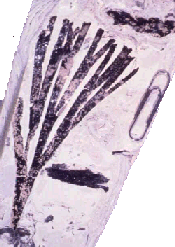
The Mesophytic (the interval following the Permo-Carboniferous perturbation) was dominated by gymnospermous (seed-bearing) plants that produced well-developed rooting structures, a reinforced aerial stem (either through pycnoxylic [Wood in which there is little or no parenchyma tissue among the xylem is called pycnoxylic. Conifers and flowering plants have pycnoxylic wood] or manoxylic wood [Wood in which there is a great deal of parenchyma tissue among the xylem is called manoxylic - Cycads and pteridosperms have manoxylic wood]), coriaceous (leathery) leaves, pollen and seeds. Although the lycopsids, sphenopsids, and pteridophytes continued to survive, most groups did not proliferate to the extent that the gymnosperms were able to evolve. These forests, open woodlands, and fern glades are known from over the globe.
The characteristics of the groups are very generalized, with pycnoxylic woods, small needle-like leaves arranged helically around ultimate branches, and stobilus-bearing. Criteria used in identifying differences in these plants include cuticular morphology (stomatal patterns, pubescence, etc.) and reproductive features of the male and female strobili.
PALISSYACEAE - Restricted to the Triassic-Jurassic, these woody shrubs/trees possessed alternately arranged vegetative branches with helical persistent leaves. Bands of stomates occur on the lower (abaxial) surface of the leaves.
PODOCARPACEAE- A southern hemisphere conifer originating in the Triassic-Recent. The northern hemisphere record of these plants is meager. The oldest Rissikia is known from Africa and Australia. These are woody trees and shrubs with scale-like linear, broad leaves helically arranged.
CUPRESSACEAE - This is the largest extant conifer family, originating in the Triassic. These evergreen, small trees/shrubs have scale-like leaves arranged either oppositely or in whorls. Permineralized woods are assigned to Cupressoxylon or Juniperoxylon. Cupressus and Juniperus (Juniper) are two extant taxa in this group.
PINACEAE - A north temperate family of conifers (largest modern family) evolving in the Triassic. Wood y trees have needle-like leaves arranged on short lateral shoots (fascicles). Most modern taxa evolved in the Tertiary and demonstrate a typical embryophyte life cycle.
ARAUCARIACEAE- A southern hemisphere conifer with limited extent in the northern hemisphere. These evergreen conifers are extant and evolved in the Jurassic. The possess helical or opposite, broad, linear leaves. These are commonly called Norfolk Island Pines. The generalized wood pattern, Araucarioxylon, has been reported in permineralized trees of lengths >60m. Recently, a species of kauri (Araucaria) thought to have been extinct in the Cretaceous has been found in a remote area of Australia. It has been named the Wollemi Pine.
TAXODIACEAE - A cosmopolitan conifer with its origins in the Jurassic and major diversification in the Cretaceous. These woody trees bear scale-like to broad leaves on deciduous branchlets and are extant today. Recent species of Taxodium (Bald Cypress) are found throughout the swamps of the Southeastern United States, whereas species of Sequoiadendron (Redwoods) are found along the west coast. The genus, Metasequoia, was originally known from the fossil record before living members of the genus was identified in the Mid-twentieth Century.
CEPHALOTAXACEAE - A limited fossil record exists for these extant woody small trees/shrubs. They possibly evolved in the Jurassic(?) And all extant species live in eastern Asia.
The woody evergreen shrubs and small trees of the Family Taxaceae have helically arranged needle-like leaves. Similar plants appear in the early Jurassic.
 |
The Ginkgos probably evolved in the late Paleophytic (Permian - Dichophyllum, Sphenobaiera) and were cosmopolitan in distribution. The habit resembles other conifer/gymnosperms, but large laminate leaves of variable shape are found on short shoots along the larger branches (shoot dimorphism - a feature not known in the fossil record). Ginkgoites resembles the modern Ginkgo in the late Triassic, such as the pictured genus Sphenobaiera. (photo courtesy of Sid Ash) |
|
The cycads are extant taxa that live in tropical and warm-temperate climates with vertical stems that are usually unbranched and columnar. Trunks may attain 18 meters in height with relatively little conducting tissue (manoxylic wood). Rates of growth are very slow, and leaves develop in spirals from the stem apex. Pinnate compound leaves exhibit xeromorphic conditions. Seeds are organized into cone structures in most taxa, although they may be borne on the edges of modified leaves (Cycas). |
 |
The earliest evidence of these plants is probably in the Late Pennsylvanian and certainly in the Early Permian. These plants are extant and have a relict diversity. That is, there are only 13 known living genera, many of which are restricted in number of individuals and geographic ranges. The Cycad Society provides photographs of the extant taxa.
| STOMATAL CHARACTERISTICS ALLOW THE SEPARATION OF CYCADS FROM OTHER CYCADOPHYTES | |
| CYCADS | CYCADEOIDS |
| Haplocheilic stomates | Syndetocheilic stomates |
| Thin cuticle over stoma | Thick Cuticle over stoma |
| Irregular orientation of stoma | Regular orientation of stoma |
| Straight-walled epidermal not well delineated in rows | Sinuous-walled epidermal cells well well delineated into rows. |
This group presumably evolved from Paleophytic pteridosperms, but the ancestral stock is still unknown. Reconstructions are based on plant part associations.
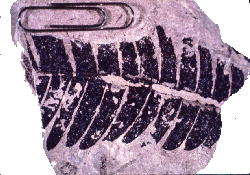 |
WILLIAMSONIACEAE - Williamsonia is a Triassic-Jurassic form known from silicified trunks and compression-impressions. These plants attained heights of up to 2 meters, with small diameters. The trunks may have been slightly branched with leaf (e.g., Ptiolphyllum at right; Photo courtesy of Sid Ash) development widely spaced along the branch. They were periodically deciduous, but no persistent leaf bases remained on the trunk. Reproductive cones are stalked, but not found among the leaf bases. The cones are unisexual. |
| CYCADEOIDACEAE- Cycadeoidea is a Late Jurassic to Middle Cretaceous form known from silicified trunks and compression-impressions. It had a similar growth habit to modern cycads, with trunks approximately 1 meter in height. Trunks may have been unbranched, barrel-shaped, or infrequently branched. Leaf bases were persistent, and arranged helically. Bisporangiate cones developed on short lateral branches within the trunk complex. It appears that some species were synchronous in the development of reproductive structures, while others were asynchronous. | 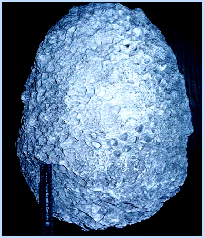 |
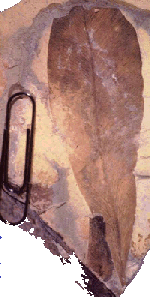 |
Known from the Upper Carboniferous to Triassic in the southern hemisphere Gondwana continents. It is the transition flora to the Dicroidium floras. Glossopterids are preserved in varved lake deposits in seasonally affected climates near/in glaciated terrains. These were trees and/or small shrubs. Photo Courtesy of Sid Ash. |
A Group of Permian to Triassic shrubs/trees known from the northern hemisphere and South Africa; probably more cosmopolitan than now recognized. The earliest representatives are known from the Permian, and are assigned to the genus Autunia (Callipteris has been used for sterile foliage).
|
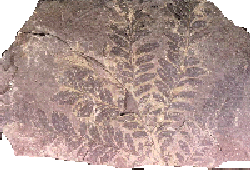 |
||
| Photo courtesy of Hans Kerp |
The Late Triassic forms differ from those of the Permian in that they are pinnate, but the reproductive structures are similar.
Triassic forms known from Gondwana continents of S. Africa, Australia, S. America (Argentina), and India. Pinnate bifurcate leaves with open dichotomous venation.
|
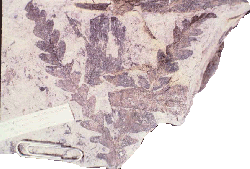
Photo courtesy of Sid Ash. |
Known from the Triassic to the Cretaceous in the northern Hemisphere.
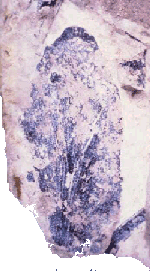
Photo courtesy of Sid Ash |
|